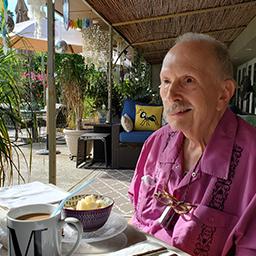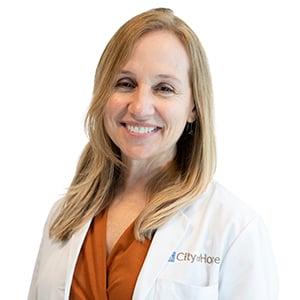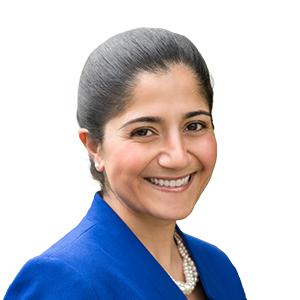Retired radiologist Michael Riozzi was successfully treated for brain cancer over 20 years ago. Thanks to his diligence and continued screening at City of Hope, recently a pancreatic tumor was discovered early.

Never say “It happens,” to Michael Riozzi.
A retired radiologist living in Palm Springs, California, the 78-year-old Riozzi likes to probe, ask questions and never accept bad news as inevitable or “just the way it is.”
That attitude may very well be key to his survival.
It’s also a good lesson for the rest of us.
Together with his longtime partner Neil Balsley, a medical marketing specialist, Riozzi has navigated two major cancer challenges in 25 years, prevailing even when doctors and conventional wisdom wrote him off.
It all started in 1999 when Riozzi was diagnosed with brain cancer.
Doctors gave him six months. “But here I am, 20 years later,” he pointed out.
Make no mistake, he earned those 20 years. Six rounds of chemo. Two rounds of gamma knife radiation. Steroids. Surgery to remove brain necrosis. His thyroid had to come out. Treatments left him with constant weakness, paralysis on one side of his face, hearing loss and blindness in one eye.
Riozzi could have chosen a milder treatment plan. But his partner says that’s not his way. (Riozzi speaks haltingly, grasping for words. Balsley frequently chimes in to finish his sentences. They’ve been together 48 years.)
“Anytime they’d say, ‘This is what you might need,’ he’d always say, ‘Do it.’” said Balsley. “Always aggressive.
“I think that’s why he’s still here.”

Riozzi came to City of Hope in the early 2000s for his once-a-year follow-up scans, handled by Jana Portnow, M.D., co-director of City of Hope’s brain tumor program and professor in the Department of Medical Oncology & Therapeutics Research. He liked Portnow immediately and was impressed by her knowledge.
The feeling was mutual.
“He’s a super sweet patient, a lovely person, and smart,” said Portnow.
Everything went perfectly fine for nearly two decades. But in fall 2021, an unexpected twist left Riozzi puzzled and suspicious.
A Puzzling Diagnosis
“I was diagnosed with diabetes, and I didn’t know why,” he recalled. “I had no risk factors, no family history, nothing.”
Given his age, people told him, “It happens.” But Riozzi was having none of that. The veteran radiologist wanted to see for himself. Knowing that a pancreatic tumor could sometimes trigger diabetes, he asked Portnow to arrange for a CT scan, just to make sure.
“He asked almost as an ‘Oh, one more thing, what do you think?’ afterthought,” Portnow recalled. “And you know, it’s hard to refuse a radiologist when he asks for a scan!”
Riozzi was right.
The CT scan showed a dilated pancreatic duct, a danger sign. A follow-up MRI revealed a mass blocking the duct, a finding that pointed to pancreatic cancer.
It was tough news to take. Pancreatic cancer kills 50,000 Americans every year. The overall survival rate has edged up slightly over the last decade, but it’s still grim: only about 11%. That’s because pancreatic cancer causes no symptoms in its earliest, most treatable stages. By the time a patient feels unwell, it can be too late.

Riozzi had no cancer symptoms. But because he insisted on investigating his unexplained diabetes, doctors caught his pancreatic tumor earlier than most. He knows he’s fortunate. His surgeon goes even further.
“He is exquisitely lucky, luckier than 80% of my patients,” said pancreatic cancer specialist and surgeon Laleh Melstrom, M.D., chief of the Division of Surgical Oncology and associate professor of Surgery and Immuno-Oncology. Melstrom says patients like Riozzi are precisely the population she and her colleagues can help. She urges anyone suddenly diagnosed with diabetes for no apparent reason to get evaluated for pancreatic cancer. She believes Riozzi’s persistence may have saved his life.
‘Advocate for Yourself’
“You must advocate for yourself,” she said. “Get a second opinion.”
Most doctors, time constrained as they usually are, may not automatically fire up the CT for a patient without symptoms simply because he develops diabetes. Riozzi persisted. “He was very specific, very focused,” she said. “He pushed for further imaging.” And it made a difference.
Riozzi’s cancer hadn’t spread. There were clear margins surrounding the tumor. Melstrom did a robot-assisted, laparoscopic procedure to remove the diseased part of the pancreas, hoping that the remainder would continue to produce insulin and perhaps reverse the diabetes. Riozzi’s spleen was also removed, “because the artery and vein of the spleen were immediately behind his tumor and involving it,” Melstrom said.
After surgery, Riozzi began chemotherapy, necessary because of a 70 to 80% risk of recurrence, either in the pancreas or nearby in the liver, lungs or abdominal wall.
A Positive Outlook
Nobody is ready to say Riozzi is “cured.” But so far, he and his doctors like what they see. And what they don’t see.
“My cancer markers went back down to normal right after surgery,” Riozzi said happily. “And now, after my third course of chemo, they’ve dropped even lower.”
Melstrom is optimistic. “Every six months without recurrence is like compound interest in the bank,” she said. “By the end of two years, we may be able to say he beat it.”
Future patients may have an easier time. New research suggests that some forms of pancreatic cancer associated with the BRCA1 and 2 mutations (most commonly linked to breast cancer) may respond to targeted therapy using PARP inhibitors, which stop cancer cells from repairing their damaged DNA. There is also promising research into the use of immunotherapy, both by itself and in combination with traditional chemo.
In the meantime, Riozzi is immensely grateful to everyone at City of Hope, especially his doctors who listened to him and acted on his concerns.
“I’m very lucky because I was suspicious,” he said. “And Dr. Portnow steered us through the maze, doing a lot of the navigation and referrals, so we could find out.”
Portnow sends the compliment right back.
“This was a good catch, and he gets the credit,” she said.
Bottom line, Riozzi and his doctors agree that the most important thing is to be aware of your own body and health at all times, and to take charge of your treatment. There’s always hope, even for pancreatic cancer. But as Riozzi likes to say, “Hope doesn’t just knock on the door. You have to ask!”
The growing population of long-term cancer survivors makes multidisciplinary survivorship research an imperative. City of Hope is home to some of the strongest programs in the country in cancer and aging and survivorship research. This ensures research includes and is relevant to patients across the lifespan.
The mission of the Center for Cancer and Aging (CCA) is to join investigators from all cancer disciplines to study the biology, treatment and survivorship issues that face older adults with cancer. This City of Hope initiative launched the nationwide Cancer and Aging Research Group.
Directed by pediatric oncologist Saro Armenian, M.D., the Center for Survivorship and Outcomes is committed to lifelong follow-up of hematology patients treated at City of Hope. This includes the Childhood, Adolescent and Young Adult Cancer Survivorship Program, which provides specialized follow-up care for patients who were diagnosed with a childhood cancer.
The Center incorporates novel real-time data collection of health outcomes during and decades after completion of therapy to inform clinicians about novel treatment strategies and risk stratification. An established blood biobank enables research on the role of genetic risk factors in severity and prevalence of complications after treatment.